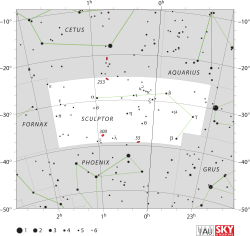Sigma Sculptoris
Sigma Sculptoris (σ Sculptoris, förkortat Sigma Scl, σ Scl) som är stjärnans Bayerbeteckning, är en ensam stjärna[11] belägen i den mellersta delen av stjärnbilden Bildhuggaren. Den har en skenbar magnitud på 5,54[2] och är svagt synlig för blotta ögat där ljusföroreningar ej förekommer. Baserat på parallaxmätning inom Hipparcosuppdraget på ca 14,0[1] mas, beräknas den befinna sig på ett avstånd på ca 232 ljusår (ca 71 parsek) från solen.
| Sigma Sculptoris (σ) | |
 | |
| Observationsdata Epok: J2000.0 | |
|---|---|
| Stjärnbild | Bildhuggaren |
| Rektascension | 01t 02m 26,43280s[1] |
| Deklination | -31° 33′ 07,22″[1] |
| Skenbar magnitud () | +5,54[2] |
| Stjärntyp | |
| Spektraltyp | A1/2IV[3] |
| U–B | +0,13[2] |
| B–V | 0,06[2] |
| Variabeltyp | Roterande variabel av Alfa2 Canum Venaticorum-typ (ACV)[4] |
| Astrometri | |
| Radialhastighet () | -15,40 ± 0,5[5] km/s |
| Egenrörelse (µ) | RA: 80,50 ± 0,35[1] mas/år Dek.: 14,64 ± 0,31[1] mas/år |
| Parallax () | 14,04 ± 0,32[1] |
| Avstånd | 232 ± 5 lå (71 ± 2 pc) |
| Absolut magnitud () | +1,24[6] |
| Detaljer | |
| Massa | 2,07[7] M☉ |
| Radie | 2,2[8] R☉ |
| Luminositet | 25,7[9] L☉ |
| Temperatur | 9 005 ± 306[7] K |
| Vinkelhastighet | 82,1 ± 1,2[10] |
| Ålder | 464[7] miljoner år |
| Andra beteckningar | |
| GEN# +1.00006178, N30 205, SKY# 1582, GSC 06999-02321, PMC 90-93 670, SRS 31026, CD-32 410, HD 6178, PPM 276619, TD1 588, CPC 17 370, HIC 4852, PS 1-77, TYC 6999-2321-1, CPD-32 108, HIP 4852, Renson 1584, UBV 1004, FK5 1026, HR 293, SAO 192884, UBV M 7870, GC 1252, IRAS 00599-3149, SB 414, uvby98 100006178, GCRV 592, 2MASS J01022643-3133070, SGPA 193[3] | |
Egenskaper
redigeraSigma Sculptoris är en blå till vit underjättestjärna av spektralklass A1/A2 IV[12]. Den har en massa som är omkring dubbelt så stor[7] som solens massa, en radie som är ca 2,2[8] gånger större än solens och utsänder från dess fotosfär ca 26[9] gånger mera energi än solen vid en effektiv temperatur på ca 9 000[7] K.
Sigma Sculptoris är en roterande variabel av Alfa2 Canum Venaticorum-typ (ACV)[4]. Den har visuell magnitud 5,5 och varierar med amplituden 0,03[4] med en periodicitet på 2,37 dygn.[13]
Se även
redigeraReferenser
redigera- Den här artikeln är helt eller delvis baserad på material från engelskspråkiga Wikipedia, tidigare version.
Noter
redigera- ^ [a b c d e f] van Leeuwen, F. (2007), "Validation of the new Hipparcos reduction", Astronomy and Astrophysics, 474 (2): 653–664, arXiv:0708.1752 , Bibcode:2007A&A...474..653V, doi:10.1051/0004-6361:20078357.
- ^ [a b c d] Westerlund, B. E. (1963), "Three-colour photometry of early-type stars near the galactic poles", Monthly Notices of the Royal Astronomical Society, 127: 83, Bibcode:1963MNRAS.127...83W, doi:10.1093/mnras/127.1.83.
- ^ [a b] ”Basic data: V* Sig Scl – Variable Star of alpha2 CVn type” (på engelska). Centre de Données astronomiques de Strasbourg. http://simbad.u-strasbg.fr/simbad/sim-basic?Ident=Sig+Scl&submit=SIMBAD+search. Läst 17 december 2017.
- ^ [a b c] ”Sig Scl” (på engelska). The International Variable Star Index. AAVSO – American Association of Variable Star Observers. http://www.aavso.org/vsx/index.php?view=detail.top&oid=34116. Läst 17 december 2017.
- ^ de Bruijne, J. H. J.; Eilers, A.-C. (October 2012), "Radial velocities for the HIPPARCOS-Gaia Hundred-Thousand-Proper-Motion project", Astronomy & Astrophysics, 546: 14, arXiv:1208.3048, Bibcode:2012A&A...546A..61D, doi:10.1051/0004-6361/201219219, A61.
- ^ Anderson, E.; Francis, Ch. (2012), "XHIP: An extended hipparcos compilation", Astronomy Letters, 38 (5): 331, arXiv:1108.4971, Bibcode:2012AstL...38..331A, doi:10.1134/S1063773712050015.
- ^ [a b c d e] David, Trevor J.; Hillenbrand, Lynne A. (2015), "The Ages of Early-Type Stars: Strömgren Photometric Methods Calibrated, Validated, Tested, and Applied to Hosts and Prospective Hosts of Directly Imaged Exoplanets", The Astrophysical Journal, 804 (2): 146, arXiv:1501.03154 , Bibcode:2015ApJ...804..146D, doi:10.1088/0004-637X/804/2/146.
- ^ [a b] Pasinetti Fracassini, L. E.; Pastori, L.; Covino, S.; Pozzi, A. (February 2001), "Catalogue of Apparent Diameters and Absolute Radii of Stars (CADARS)", Astronomy and Astrophysics (3rd ed.), 367: 521–524, arXiv:astro-ph/0012289, Bibcode:2001A&A...367..521P, doi:10.1051/0004-6361:20000451.
- ^ [a b] McDonald, I.; et al. (2012), "Fundamental Parameters and Infrared Excesses of Hipparcos Stars", Monthly Notices of the Royal Astronomical Society, 427 (1): 343–57, arXiv:1208.2037, Bibcode:2012MNRAS.427..343M, doi:10.1111/j.1365-2966.2012.21873.x.
- ^ Díaz, C. G.; et al. (July 2011), "Accurate stellar rotational velocities using the Fourier transform of the cross correlation maximum", Astronomy & Astrophysics, 531: A143, arXiv:1012.4858, Bibcode:2011A&A...531A.143D, doi:10.1051/0004-6361/201016386.
- ^ Eggleton, P. P.; Tokovinin, A. A. (September 2008), "A catalogue of multiplicity among bright stellar systems", Monthly Notices of the Royal Astronomical Society, 389 (2): 869–879, arXiv:0806.2878, Bibcode:2008MNRAS.389..869E, doi:10.1111/j.1365-2966.2008.13596.x.
- ^ Houk, Nancy (1979), Michigan catalogue of two-dimensional spectral types for the HD stars, 3, Ann Arbor, Michigan: Dept. of Astronomy, University of Michigan, Bibcode:1982mcts.book.....H.
- ^ Catalano, F. A.; Renson, P. (February 1998), "The observed periods of AP and BP stars", Astronomy and Astrophysics Supplement, 127: 421–422, Bibcode:1998A&AS..127..421C, doi:10.1051/aas:1998110.



